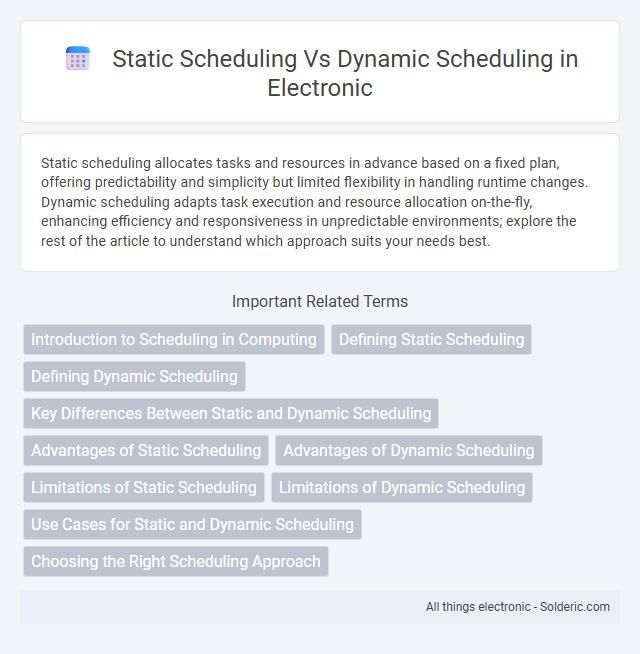Static scheduling allocates tasks and resources in advance based on a fixed plan, offering predictability and simplicity but limited flexibility in handling runtime changes. Dynamic scheduling adapts task execution and resource allocation on-the-fly, enhancing efficiency and responsiveness in unpredictable environments; explore the rest of the article to understand which approach suits your needs best.
Comparison Table
| Aspect | Static Scheduling | Dynamic Scheduling |
|---|---|---|
| Definition | Schedules tasks at compile-time | Schedules tasks at run-time |
| Flexibility | Low, fixed task order | High, adapts to runtime events |
| Overhead | Minimal runtime overhead | Higher runtime overhead |
| Use Cases | Real-time systems, predictable workloads | General-purpose systems, uncertain workloads |
| Complexity | Simple to implement | Complex due to runtime decisions |
| Resource Utilization | May underutilize resources | Better resource utilization |
| Examples | Static priority scheduling, fixed time slots | Dynamic priority scheduling, time-sharing |
Introduction to Scheduling in Computing
Scheduling in computing manages the execution order of tasks to optimize resource utilization and system performance. Static scheduling assigns tasks at compile-time based on predetermined criteria, ensuring predictability but limiting flexibility under varying workloads. Dynamic scheduling, however, allocates tasks at runtime, adapting to changing system states and improving responsiveness, which benefits your system's efficiency in unpredictable environments.
Defining Static Scheduling
Static scheduling assigns tasks to resources before execution begins, based on predetermined criteria, enabling predictable and efficient use of computing resources. It is commonly used in real-time systems and embedded applications where timing guarantees are critical and workloads are well understood. Static scheduling minimizes runtime overhead by eliminating the need for dynamic decision-making, but lacks flexibility in handling unpredictable workloads.
Defining Dynamic Scheduling
Dynamic scheduling is a method used in computer architecture where the processor decides the execution order of instructions during runtime, optimizing resource utilization and minimizing delays caused by pipeline hazards. Unlike static scheduling, which is predetermined at compile time, dynamic scheduling adapts to instruction dependencies and availability of functional units in real-time. Techniques such as Tomasulo's algorithm and out-of-order execution exemplify dynamic scheduling by allowing instructions to execute as soon as their operands are ready, improving overall CPU performance and efficiency.
Key Differences Between Static and Dynamic Scheduling
Static scheduling allocates resources and plans tasks at compile-time, providing predictable execution and minimal runtime overhead. Dynamic scheduling assigns tasks during runtime based on system state, enhancing flexibility and resource utilization but increasing overhead. Your choice depends on the need for predictability versus adaptability in task management.
Advantages of Static Scheduling
Static scheduling offers predictable execution, enabling precise resource allocation and minimizing runtime overhead. It allows for efficient compile-time optimization, resulting in improved system performance and reduced latency. This approach ensures greater system stability and easier debugging due to its deterministic nature.
Advantages of Dynamic Scheduling
Dynamic scheduling improves CPU utilization by allowing instruction execution out-of-order, which reduces idle time and mitigates hazards like data dependencies and resource conflicts. Your system benefits from increased instruction-level parallelism and enhanced adaptability to unpredictable workloads, leading to better overall performance. This flexibility enables dynamic scheduling to optimize throughput even in complex pipeline architectures.
Limitations of Static Scheduling
Static scheduling limits your system's flexibility by assigning tasks at compile time, making it difficult to adapt to unpredictable workloads or runtime conditions. It often results in inefficient resource utilization when task execution times vary or when tasks depend on dynamic data. This rigidity can cause delays and reduce overall performance in environments with fluctuating demands or real-time constraints.
Limitations of Dynamic Scheduling
Dynamic scheduling faces limitations such as increased hardware complexity and power consumption due to the need for real-time instruction reordering and dependency checking. It can also introduce pipeline stalls and unpredictable execution latency, which reduce overall system performance in certain workloads. Moreover, dynamic scheduling requires sophisticated control logic, making it less suitable for low-power or resource-constrained environments compared to static scheduling.
Use Cases for Static and Dynamic Scheduling
Static scheduling is ideal for predictable environments such as embedded systems and real-time applications where task priorities and execution times are known in advance, ensuring deterministic performance. Dynamic scheduling suits complex, multi-threaded systems like operating systems and cloud computing platforms that require adaptive resource allocation to optimize throughput and handle unpredictable workloads. Workflows with fixed timelines benefit from static scheduling, while environments with variable task loads rely on dynamic scheduling for improved flexibility and responsiveness.
Choosing the Right Scheduling Approach
Static scheduling allocates tasks based on predetermined criteria, ideal for predictable environments with minimal runtime variability, enhancing system stability and simplifying resource management. Dynamic scheduling adapts task allocation in real-time, optimizing performance and resource utilization in systems with varying workloads or unpredictable conditions. Selecting the right approach depends on factors such as system predictability, overhead tolerance, and the need for flexibility in handling runtime changes.
static scheduling vs dynamic scheduling Infographic

 solderic.com
solderic.com